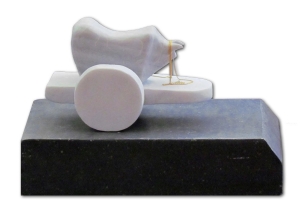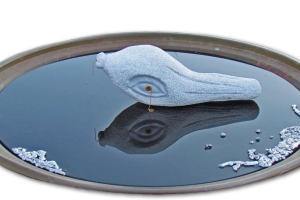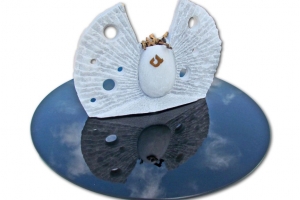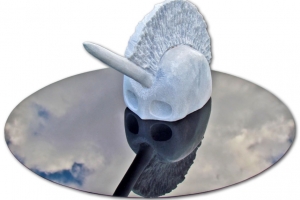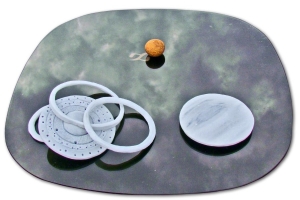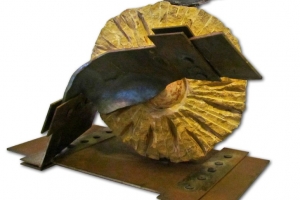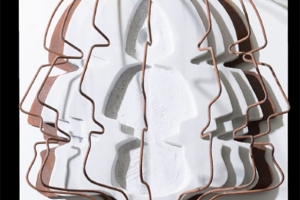AVI SPERBER - ALEF by Dr. Dalia Hakker-Orion - Curator
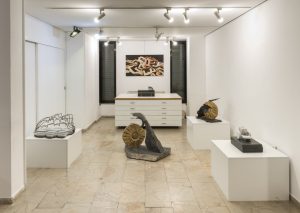 The veteran sculptor Avi Sperber presents a new series of work on the theme of the “Golem” under the title “ALEF” at the Efrat Gallery in Tel-Aviv. The series was started following a trip to Prague and an exhibition in the Vernon Gallery in the city, and finished on his return to Israel. Avi is nourished from the rich world of literature, poetry, exhibitions and meetings.
The veteran sculptor Avi Sperber presents a new series of work on the theme of the “Golem” under the title “ALEF” at the Efrat Gallery in Tel-Aviv. The series was started following a trip to Prague and an exhibition in the Vernon Gallery in the city, and finished on his return to Israel. Avi is nourished from the rich world of literature, poetry, exhibitions and meetings.
From these encounters he draws visual images that take shape in his studio in Ein Carmel.
The connection between the different fields is known as ‘synesthesia’ and it constitutes the first trigger in revealing the visual images. Avi creates while working the stone and not necessarily by outline. Avi Sperber divides his time between work as an engineer and his art and produces an abundant amount of work built around a central theme. Avi’s work has been exhibited in solo and group exhibitions in Israel and abroad and his outdoor sculptures are positioned in several sites in Israel. He started using stone as his work material by process of elimination and has stayed loyal to it. Avi conducts an exciting conversation with the stone, producing sculptures that are coherent and rich in sources and ideas.
He prefers working with hard stones that require strength and effort and succeeds in reaching, according to his choice, interesting internal layers
on the one hand, and at times a level of processing that leaves a layer the width of several millimeters, allowing the light to be reflected through it. The light and the eye that is able to see it are one of the important elements in Avi’s work.
Avi’s sculptures are minimalistic with encounters between smooth and rough areas. There is an emphasis on the symbolism that is reflected in the description of an element or a certain color. Sometimes there is a combination of additional materials.
The subjects of his work are proof of his love of nature, Israel, people, the mystery of life and creation, culture and heritage.
He describes in different ways the many realizations and revelations that are transmitted from the Godly energy to mankind and are revealed in our world through flora, the cycle of nature (which is also found in ancient art), transformations and the power of letters. In the exhibition he exhibits letters, encounters and characters such as. Samson, Delilah and Cain (the mark on his forehead saved him from death), an encounter between ‘Tycho Brahe’ and the ‘Maharal’, the ark of the covenant, alchemy, the golden calf and more.
Avi illustrates abstract themes and reveals principles of continuity, renewal, encounters, strength, metamorphosis, power and more.
Dr. Dalia Hakker-Orion – Curator

THE GOLEM – BETWEEN HEAVEN AND EARTH Avi Sperber
 The story of the creation of the Golem by the Maharal was written 200 years after his death. Despite the fact that there is no proof attesting to the veracity of the legend, the Golem has become a concept incorporating not a few symbols and implications for how we view life itself and the history of the Jewish people and the world.
The story of the creation of the Golem by the Maharal was written 200 years after his death. Despite the fact that there is no proof attesting to the veracity of the legend, the Golem has become a concept incorporating not a few symbols and implications for how we view life itself and the history of the Jewish people and the world.
The Golem, as perceived by Rabbi Moshe Kordovro (HaRamak), is the image of God incorporated in man. God created man in his image and his visage. however as the image of God is multifaceted, so are the many faces of man, which we can see in the varied psychological masks which a man will wear in different situations.
To create a Golem is an effort by man to create another man – an effort doomed to failure from the outset. The aspiration is to replicate the acts of God, in fact an attempt to be God. The fact is that despite the creation of a Golem using the letters of the alphabet, the creation cannot speak – in other words, he cannot make any use of them.
According to the Kabbalah, the world was created by God with words using a combination of letters from the Hebrew alphabet. The creation of man is also dependent on the formulation of the correct combination of letters. Many have dabbled in this effort before the Maharal and there are other stories of the creation of a Golem by other Rabbis and scholars for their personal needs. The word is the spirit, the soul, but in order to create a man there was a need for the material as well. Shin Shalom, in his book “Understanding the Kabbalah and its Symbols”, claims that before the soul was injected and before he was given speech, Adam was just an unformed mass of material – a Golem, which in size extended from one end of the universe to the other. By giving him a soul and the word, he received a form. This is a mystical approach to the creation of man which occurs through the connection between God and the earth.
At the time of the Maharal, the most prominent astronomer of his time, Tycho Brahe, lived in Prague. As David Ganez was a student of both these great figures, we can assume they also met each other. Both were involved in investigating the nature of creation – The Maharal the creation of man and Brahe the creation of the world and the cosmos. Thus the meeting of the two would symbolize the attempt to decipher the godly code, the link between heaven and earth, in both the practical and spiritual senses.
The Golem created by the Maharal using the formulation of letters אמת (“truth”) received life through the letter א(Alef), which from his perspective symbolized life and death. In the Kabbalistic tradition, the letter symbolizes infinity, the unlimited godly powers.
The form of the letter א is likened to a person pointing with one hand to the heavens and with the other to the earth, hinting to us that what takes place in this world is an indication of what is happening above. Similarly, the existence of the Golem links the earthly and the spiritual together.
Cain was also the recipient of a mark which in Hebrew is also a letter. The mark gave him life – without it he would be considered dead. What is the mark? Jose Saramago in his book “Cain” determined that the mark was “a black sun that rises from the horizon of the eyes”.
I chose to represent the mark as the horn of a unicorn which is a phallic element representing masculinity in the soul, order, form and the control of impulse. The unicorn’s horn was, according to many traditions, the longing of the soul as it encompasses the qualities of healing from death, in other words the ability to achieve life without end.
Cain, who in reality brought the first death into the world of conscience (the unicorn represents the conscience) led his destructive impulses to positive actions. He built a city, his descendants were the ancestors of art, and he was transformed to be the father of creativity and man’s push to progress.
Incidentally, one can note that the word “golem” in Hebrew represents a stage in the development of a butterfly, the pupa .The inanimate Golem receives the breath of life and turns into a butterfly, to spirituality. The butterfly symbolizes the connection between earthliness and spirituality, between the inanimate and the living.
The concept of a Golem was known in other traditions from ancient Greece to Christian traditions which led to ideas for the actual creation of a man using alchemy. An example is the idea of Paracelsus to create a Homunculus – a miniature man. These ideas have clear parallels to the Golem in the Jewish tradition. Alchemy deals with material cycles that transform the material from within, from the initial state of internal conflict to the stage of integration and completion. The alchemists strived to find the basic force that allowed the material world to come into existence. They tried to discover the secret of how material changes and transform the secret of life and the mysteries of creation in order to achieve eternity and life without end.
The Philosopher’s Stone (lapis lazuli) – the object of the process and the Alchemist’s search, is the element that enables the transformation of a lowly material (lead) to a supreme material, that is, gold. The Philosopher’s Stone is sometimes referred to as the “The Elixir of Life”. It is the goal of the Alchemist’s search, as it enables the mysterious process of the creation of life and it is equivalent to perfection – to gold. Gold as representing the material of beauty, shiny , precious, complete, not corrodible – and therefore considered immortal, eternal, and godly.
The meeting between the inanimate Golem and the godly spirit finds expression in the Torah in the story of the Golden Calf. Aaron forged a Golden Calf – an inanimate golem – as a god, in contrast to Moses, who descended the mountain carrying the Ten Commandments, written in stone by the hand of God.
Moshe Edell, in his book “Golem”, tells us that similar to the processes of creating a Golem that were even discussed in the Talmud, others primarily at the time of the Ralbag (Rabbi Levi ben Gershon) tried to call upon the heavenly powers to give an inanimate object power and life force.
Calling on the heavenly powers was accompanied by a ceremony which included combining various metals and the burning of incense, which remind us of alchemy. Those rabbis that dealt in mystical topics (“Mekubalim”) considered these processes valid but forbidden, in similarity to Aharon and his creation of the Golden Calf.
From this we can conclude that the Golden Calf was a talisman, that is a metal object used to draw magical forces to the earth.
The Ralbag claimed that “the small idols are objects in the form of a person made of metal.
At times known to them, a power within is awoken which by magic would seem to allow them to speak…”. Ben Biliah hints at the connection between the small idols to the Cherubs in the Holy of Holies (in the Holy Temple in Jerusalem). Two of the Cherubs placed such that a space was created for the Holy Spirit (“Shechinah”). The role of the Cherubs was to bring astral spiritual power to the earth, so that actually the Cherubs, in the end, were astral talisman-Golems.
The purpose of the Maharal in creating the Golem was to protect the Jews form the threats all around them, and therefore it was created with an aggressive nature with the godly א allowing control over its powers and inclinations. A similar story can be seen in the story of Samson in the Book of Judges, who was born at the word of God (the angel) and even in Hebrew his name hints of beatific birth from the sun, the mother of all life. In fact Samson was a powerful Jewish bully whose path and fate in life was set by his impulses and his lusts. As mentioned, there is a basis to argue that name “Samson” (in Hebrew “Shimshon”) is taken from the word in Hebrew for “Sun” – “Shemesh”, and that the story of Samson and Delilah is a remnant of pagan beliefs in the war of light against darkness, in which Delilah represents a golem – power of a differing sort. This is a feminine power, soft, dark and threatening, the power of the night which enwraps the light. Scholars of the Talmud and later rabbis argued extensively about the nature of the Golem – whether he is an earthly object or a person created with God’s spirit. These discussions do not reach a clear conclusion, and the concept of the Golem remains suspended somewhere between earth and heaven.
Avi Sperber
